Architecture of Hong Bang times of Văn Lang's country
Traditional Vietnamese architecture concept from Hong Bang of Văn Lang dynasty to Hùng Vương dynasty, then nowaday.
Kiến trúc cổ truyền từ khái niệm thời Hồng Bàng nước Văn Lang triều đại Hùng Vương, còn lưu truyền hoặc phảng phất nét kiến trúc thời đó.
1

Baiyue refers to hundred different tribes, they’re all different ethnic groups. In the word Baiyue, Bai百 means “hundred”, and the ancient of Vietnamese was one of the Baiyue (them).
Trăm bộ tộc Việt của nhiều sắc dân có văn hóa riêng, ngôn ngữ riêng. Trong chữ "Trăm Việt" có ý là nhiều lắm, và trong số trăm bộ tộc Việt đó, có bộ tộc Lạc Việt trong đó. Vietnamese has many reasons to take pride in being Vietnamese, they don’t need to pretended to be Chinese for to feel supper. Take pride in your own culture, heritage, identity and destiny.
Người Việt Nam có nhiều lý do để tự hào là người Việt Nam, họ không cần phải giả vờ làm người Tàu để cảm thấy "được vĩ đại". Hãy tự hào về văn hóa, di sản, bản sắc và sắc tộc của riêng nước bạn.
Don’t compare yourself to the rich neighbor or pretend to be them.
Chinese in general doesn’t even care nor notice if you are Cantonese, or Quảng Tây, or shanghai people presence.
Vietnam is just too small and irrelevant. We work hard to build your country, once you are prosperous and strong, maybe Chinese will want to pretend to be Vietnamese.
Đừng so sánh mình với người hàng xóm giàu có hoặc giả vờ là họ.
Người Tàu nói chung thậm chí không quan tâm cũng như không chú ý nếu bạn là người Quảng Đông, hoặc Quảng Tây, hay sự hiện diện của bạn là người Thượng Hải.
Việt Nam quá nhỏ và không liên quan. Chúng tôi làm việc chăm chỉ để xây dựng đất nước của bạn, một khi bạn thịnh vượng và mạnh mẽ, có thể người Tàu sẽ muốn giả vờ là người Việt Nam.
Mường minority ethnic house
Hình: Một kiểu Ngôi nhà của Sắc tộc thiểu số người Mường. 2

The Yue people 越 were shown on Dong Son brass drums and on other brass drums in Southern China. The Yue people were associated with the dagger-axe: 戈 are indigenous people, before the Chinese people invasion/took land of these aboriginal Viet.
Hình ảnh trên mặt trống đồng Ngọc Lũ
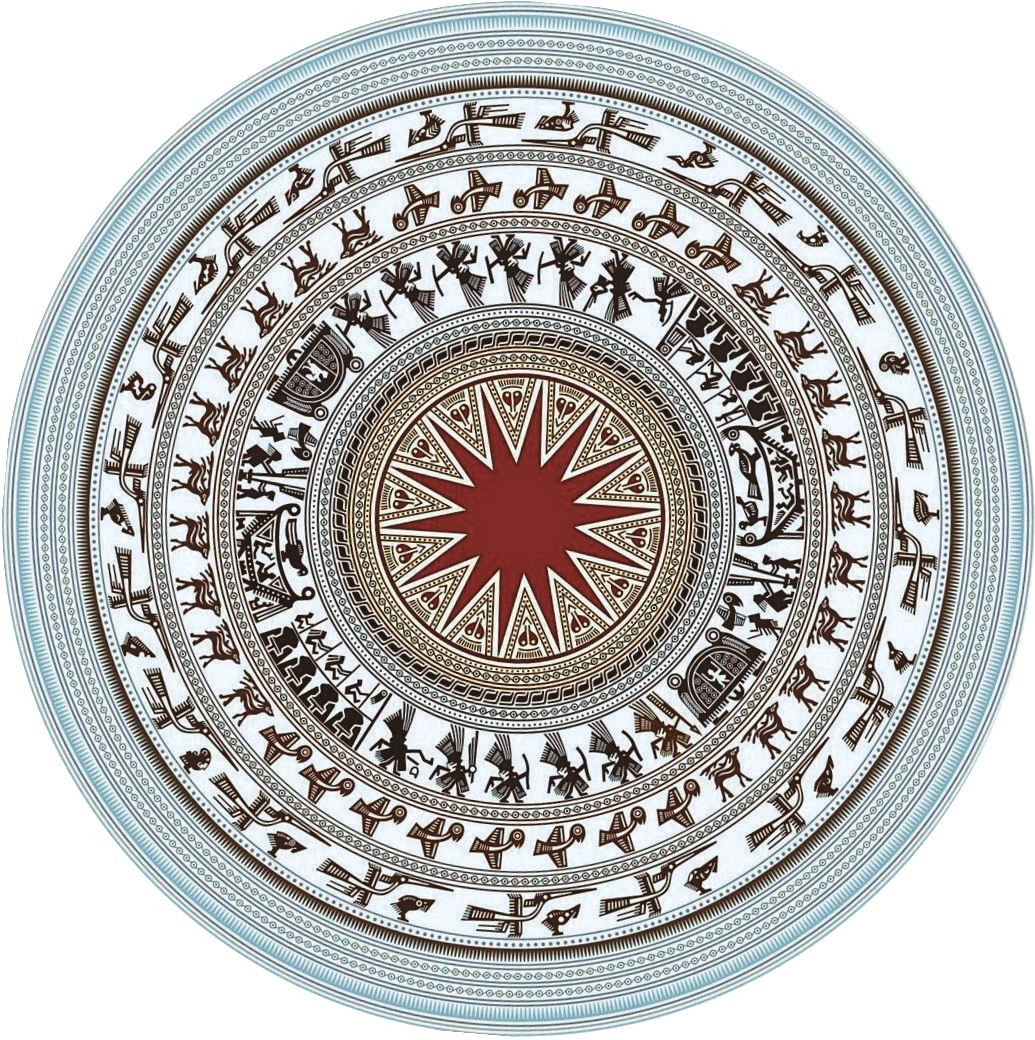
3
Kinh Dương Vương the kingdom of Văn Lang (initially called Xích Quỷ) in 2879 BC.
Kinh Dương Vương là vua của vương quốc Văn Lang (ban đầu gọi là Xích Quỷ) năm 2879 TCN.
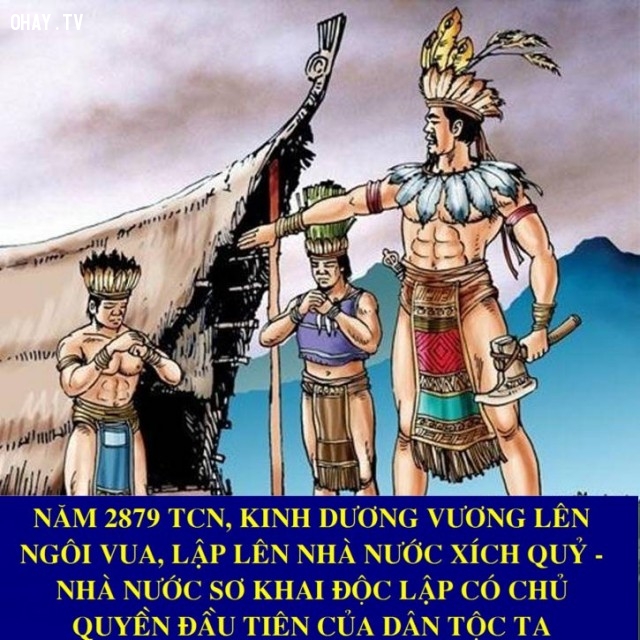
4
Sinh hoạt thường ngày của người Việt cổ, nhiều mái nhà kiểu cong góc cùng những mái nhà sàn phỏng theo mô tả bằng hình trong trống đồng Ngọc Lũ.

33
Hình mái nhà uốn cong trong trống đồng Ngọc Lũ

Hình ảnh trên Trống Đồng Ngọc Lũ (Bronze Drum)

All the drums are the same 14-pointed star representing of the sun! https://qph.cf2.quoracdn.net/main-qimg-be5a070daf51e6ddd95096ac555283d7-lq =3

Văn hóa Đông Sơn - được 'ghi lại' trên trống đồng Mái nhà uốn cong lên theo kiến trúc phỏng theo mô tả bằng hình trong trống đồng Ngọc Lũ.

5
Hình: xâm mình, Vẽ mặt, đội lông chim

Người Việt tiền sử có tục xâm mình, vẽ mặt, đội lông chim, điều nầy cũng thấy rõ ở thổ dân Châu ÚC và Châu Mỹ La-tinh.

6
Trước thế giặc mạnh, vua Hùng đã họp các Lạc tướng lại để bàn việc chống giặc
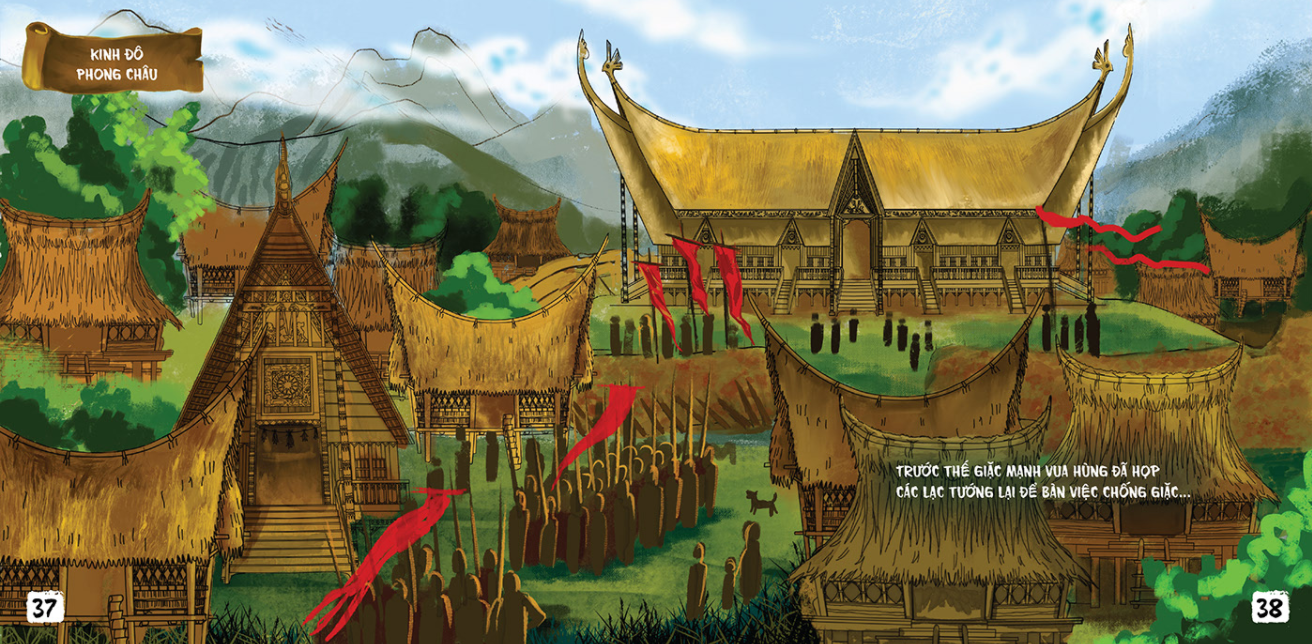
Hùng Vương house phỏng theo sự trống đồng Ngọc Lũ:
8

The portraits of Hùng Kings and their subjects were just like tropical tribal people:
7
Viet Tribes

8
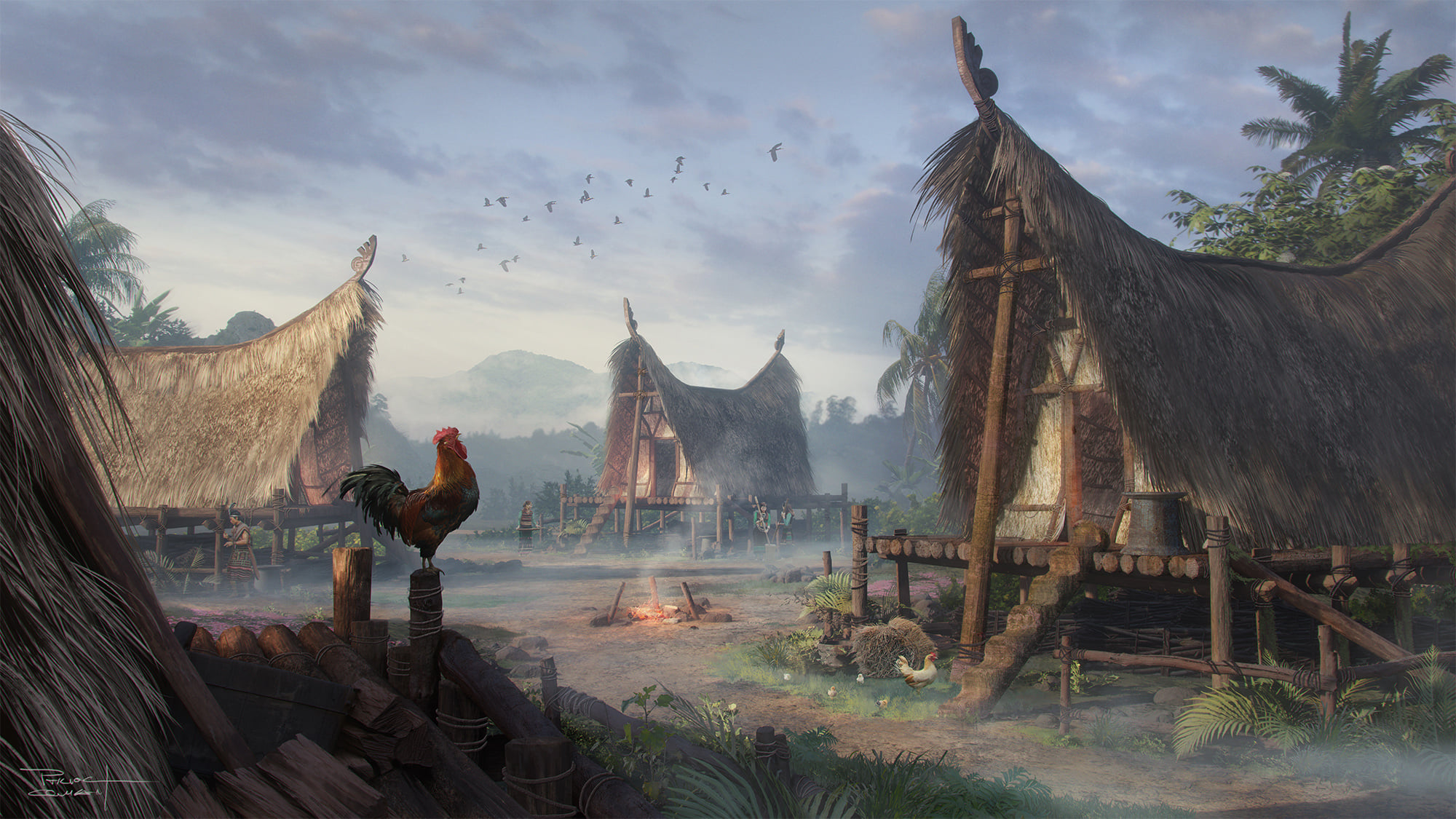
9

Đình làng Việt Nam phỏng theo kiến trúc của thời Hùng Vương.
Mái đình nhà uốn cong theo kiến trúc xưa
The ancient Vietnamese village house is adapted from the architecture of the Hung Vuong period just like tropical tribal people:.
The roof of the house bends according to the old architecture
10

Old Hung Lo communal house with curl roof tail in North Vietnam in style of Hồng Bàng era.
Đình Hưng Lo cổ ở miền Bắc Việt Nam có đuôi mái xoắn theo phong cách thời đại Hồng Bàng.
11

12
Central Việt Nam is imperial style, as well as derivatives of imperial styles. They’re recognizable through their very colorful and (at times) garish decorations as well as cylindrical tiles.
Miền Trung Việt Nam là phong cách hoàng gia, cũng như các dẫn xuất của phong cách hoàng gia. Chúng có thể nhận ra thông qua các đồ trang trí rất sặc sỡ và (đôi khi) cũng như gạch hình trụ.

13
Southern Việt Nam style is a derivative of central style, but with Western influences.
Miền Nam Việt Nam có phong cách giống miền Trung nhưng lại mang ảnh hưởng của phương Tây.

Đông Sơn’s drums
14

*Dong Son drum*
15
The Đôngsơn bronze drum and the Lạc bird have become a de facto symbol of the Vietnamese people.

16

17

18
Lịch sử Bách-Việt còn hay nhắc lại những khám phá ra việc người Việt giỏi dùng ghe, thuyền di chuyển trên sông biển và trồng lúa, cắt tóc ngắn để dễ làm việc đồng án ở ruộng lúa nước…
Viet Tribes, according the deputy from the Bronze drum

19

20
Thuyền

Mặt trống

Hình ảnh trên mặt trống đồng Ngọc Lũ

04= Nóc nhà 1 trên trống

= 4 Nóc nhà 2

https://i.pinimg.com/564x/f7/50/30/f7503045da423f8ee0d7485551e5672f.jpg
55
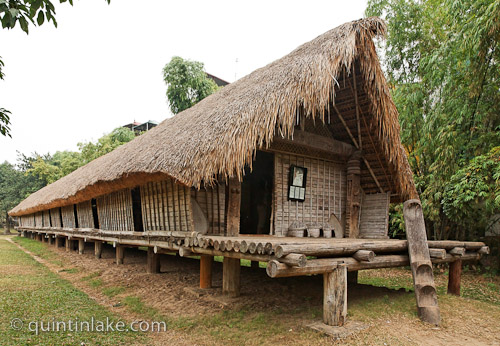
Một ngôi nhà sàn dài trong buôn làng Buôn Jun của người Mnong tại Cao Nguyên Việt Nam. (www.en.wikipedia.org)
5=

Common Austronesian house structures in Indonesia and Malaysia
Cấu trúc nhà Nam Đảo/Austronesian phổ biến ở Nam Dương/Indonesia và Mã Lai Á/Malaysia
= 66 Giai Điệu Cồng Chiêng Ha Tây | RUPtv Media
RUP Media
https://youtu.be/woN7XQlKgak

https://luocsutocviet.files.wordpress.com/2018/06/nhasanfix_zps0d9b4cba.jpg
nhà rong

=6
Nhà Rông of Vietnam

On Ritual and Resilience: The Nhà Rông of Vietnam
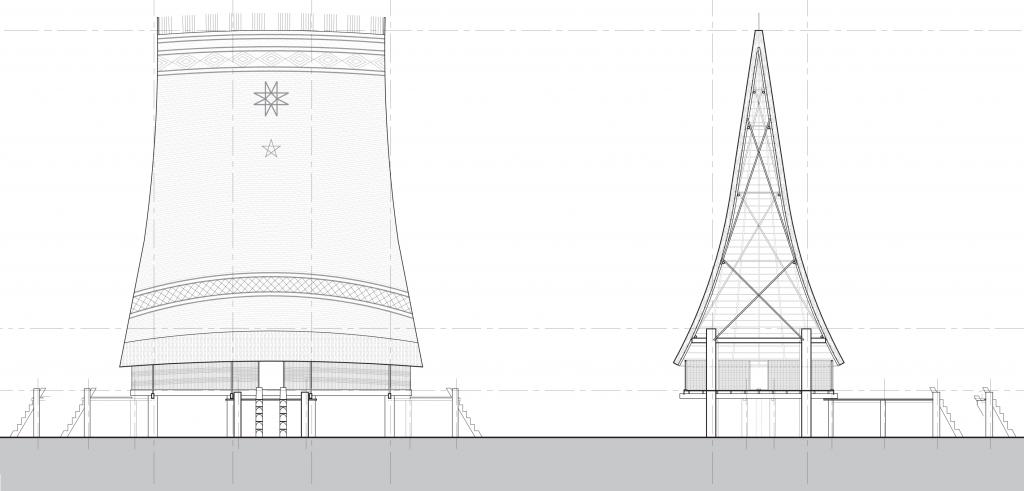
Rachel Kaplan
A chapel, a courthouse, a barracks, a beacon. For hundreds of years, the rong house, or Nhà Rông, has functioned as a spiritual, cultural, administrative, and focal center of minority villages throughout Vietnam's Central Highlands. Distinguishable by its massive, steeply pitched roof, stilt construction, large balconies, and locally sourced materials, the formal manifestation of the Nhà Rông is a rich juxtaposition of context and symbol. A Nhà Rông is part of the visual identity of a village, and as such, the scale and elaborateness of the rong are seen as a reflection of the power and wealth of the village itself.
In the modern sociopolitical landscape of central Vietnam, the troubled relationship between the Vietnamese government and the ethnic minority groups in the region can be seen in subtle and overt ways. Ethnic groups residing in the Central Highlands, known collectively as the Montagnards, or "people of the mountain," have a long and brutal history of conflict with the Vietnamese majority and have battled persecution, violence, displacement, discrimination, and state-sponsored colonization. Within this context, the role of the Nhà Rông is ever-changing. As external forces are threatening ethnic communities, some are forging closer bonds with their histories, while others are moving away towards a modern and globalized future. Thus, the Nhà Rông of the 21st century is a varied and fluid concept. While almost always still present, either by choice or government mandate, it can reflect identity or represent an anachronism.
On Ritual and Resilience: The Nhà Rông of Vietnam is a formal and contextual investigation of the Nhà Rông as a vernacular building type. The exhibition showcases four prototypical Nhà Rông from the Kon Tum and Gia Rai provinces in Vietnam. Through a series of technical drawings and photographs, the project investigates the unique qualities of the Nhà Rông across different ethnic groups and localities, and studies how environmental, political, and other factors have influenced the design, use, and contextual development.
Rachel Kaplan (M.Arch. '14) is an architectural designer at MDSzerbaty Associates in New York City. On Ritual and Resilience: The Nhà Rông of Vietnam presents research funded by the 2017–18 Eidlitz Travel Fellowship.
Related Links
Robert James Eidlitz Fellowship Information
Source: https://aap.cornell.edu/news-events/rachel-kaplan-ritual-and-resilience-nh-r-ng-vietnam
=7

https://i.pinimg.com/564x/a2/e0/18/a2e01851b5d55dd91f2a2214b981bac7.jpg
=9

https://i.pinimg.com/564x/23/c9/eb/23c9ebf4912e4b0311ee2316bba12d36.jpg
13

=10
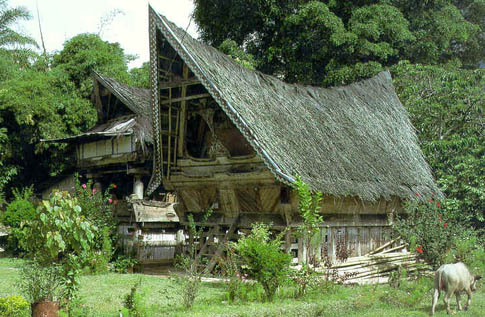
https://www.webpages.uidaho.edu/arch499/nonwest/indonesia/Toba2.jpg
11

22

13

https://luocsutocviet.files.wordpress.com/2018/06/nhasanfix_zps0d9b4cba.jpg?w=656&h=300&crop=1
Nguyễn architecture was influenced by Later Lê styles (the previous dynasty of Vietnam) and Southeast Asian aesthetics.
11

Southeast Asian aesthetics.
22

Thị Trấn Sương Mù
https://youtu.be/GTbccY8mi6M

House in Nias North Sumatra


a

Tongkonan traditional house in Lempo village. Tana Toraja, Sulawesi. Indonesia

Tongkonan Traditional House, Tana Toraja, Indonesia
Peaked Roof of Tana Toraja Boat House

Replica of Melaka s Sultante Palace


Traditional Vietnamese architecture concept from Hong Bang of Văn Lang dynasty to Hùng Vương dynasty, then nowaday.
Kiến trúc cổ truyền từ khái niệm thời Hồng Bàng nước Văn Lang triều đại Hùng Vương, còn lưu truyền hoặc phảng phất nét kiến trúc thời đó.
1
Baiyue refers to hundred different tribes, they’re all different ethnic groups. In the word Baiyue, Bai百 means “hundred”, and the ancient of Vietnamese was one of the Baiyue (them).
Trăm bộ tộc Việt của nhiều sắc dân có văn hóa riêng, ngôn ngữ riêng. Trong chữ "Trăm Việt" có ý là nhiều lắm, và trong số trăm bộ tộc Việt đó, có bộ tộc Lạc Việt trong đó. Vietnamese has many reasons to take pride in being Vietnamese, they don’t need to pretended to be Chinese for to feel supper. Take pride in your own culture, heritage, identity and destiny.
Người Việt Nam có nhiều lý do để tự hào là người Việt Nam, họ không cần phải giả vờ làm người Tàu để cảm thấy "được vĩ đại". Hãy tự hào về văn hóa, di sản, bản sắc và sắc tộc của riêng nước bạn.
Don’t compare yourself to the rich neighbor or pretend to be them.
Chinese in general doesn’t even care nor notice if you are Cantonese, or Quảng Tây, or shanghai people presence.
Vietnam is just too small and irrelevant. We work hard to build your country, once you are prosperous and strong, maybe Chinese will want to pretend to be Vietnamese.
Đừng so sánh mình với người hàng xóm giàu có hoặc giả vờ là họ.
Người Tàu nói chung thậm chí không quan tâm cũng như không chú ý nếu bạn là người Quảng Đông, hoặc Quảng Tây, hay sự hiện diện của bạn là người Thượng Hải.
Việt Nam quá nhỏ và không liên quan. Chúng tôi làm việc chăm chỉ để xây dựng đất nước của bạn, một khi bạn thịnh vượng và mạnh mẽ, có thể người Tàu sẽ muốn giả vờ là người Việt Nam.
Mường minority ethnic house
Hình: Một kiểu Ngôi nhà của Sắc tộc thiểu số người Mường. 2
The Yue people 越 were shown on Dong Son brass drums and on other brass drums in Southern China. The Yue people were associated with the dagger-axe: 戈 are indigenous people, before the Chinese people invasion/took land of these aboriginal Viet.
Hình ảnh trên mặt trống đồng Ngọc Lũ

3
Kinh Dương Vương the kingdom of Văn Lang (initially called Xích Quỷ) in 2879 BC.
Kinh Dương Vương là vua của vương quốc Văn Lang (ban đầu gọi là Xích Quỷ) năm 2879 TCN.

4
Sinh hoạt thường ngày của người Việt cổ, nhiều mái nhà kiểu cong góc cùng những mái nhà sàn phỏng theo mô tả bằng hình trong trống đồng Ngọc Lũ.
33
Hình mái nhà uốn cong trong trống đồng Ngọc Lũ

Hình ảnh trên Trống Đồng Ngọc Lũ (Bronze Drum)

All the drums are the same 14-pointed star representing of the sun! https://qph.cf2.quoracdn.net/main-qimg-be5a070daf51e6ddd95096ac555283d7-lq =3

Văn hóa Đông Sơn - được 'ghi lại' trên trống đồng Mái nhà uốn cong lên theo kiến trúc phỏng theo mô tả bằng hình trong trống đồng Ngọc Lũ.
5
Hình: xâm mình, Vẽ mặt, đội lông chim
Người Việt tiền sử có tục xâm mình, vẽ mặt, đội lông chim, điều nầy cũng thấy rõ ở thổ dân Châu ÚC và Châu Mỹ La-tinh.
6
Trước thế giặc mạnh, vua Hùng đã họp các Lạc tướng lại để bàn việc chống giặc

Hùng Vương house phỏng theo sự trống đồng Ngọc Lũ:
8
The portraits of Hùng Kings and their subjects were just like tropical tribal people:
7
Viet Tribes
8

9
Đình làng Việt Nam phỏng theo kiến trúc của thời Hùng Vương.
Mái đình nhà uốn cong theo kiến trúc xưa
The ancient Vietnamese village house is adapted from the architecture of the Hung Vuong period just like tropical tribal people:.
The roof of the house bends according to the old architecture
10
Old Hung Lo communal house with curl roof tail in North Vietnam in style of Hồng Bàng era.
Đình Hưng Lo cổ ở miền Bắc Việt Nam có đuôi mái xoắn theo phong cách thời đại Hồng Bàng.
11
12
Central Việt Nam is imperial style, as well as derivatives of imperial styles. They’re recognizable through their very colorful and (at times) garish decorations as well as cylindrical tiles.
Miền Trung Việt Nam là phong cách hoàng gia, cũng như các dẫn xuất của phong cách hoàng gia. Chúng có thể nhận ra thông qua các đồ trang trí rất sặc sỡ và (đôi khi) cũng như gạch hình trụ.
13
Southern Việt Nam style is a derivative of central style, but with Western influences.
Miền Nam Việt Nam có phong cách giống miền Trung nhưng lại mang ảnh hưởng của phương Tây.
Đông Sơn’s drums
14
*Dong Son drum*
15
The Đôngsơn bronze drum and the Lạc bird have become a de facto symbol of the Vietnamese people.
16
17

18
Lịch sử Bách-Việt còn hay nhắc lại những khám phá ra việc người Việt giỏi dùng ghe, thuyền di chuyển trên sông biển và trồng lúa, cắt tóc ngắn để dễ làm việc đồng án ở ruộng lúa nước…
Viet Tribes, according the deputy from the Bronze drum
19

20
Thuyền

Mặt trống
Hình ảnh trên mặt trống đồng Ngọc Lũ

04= Nóc nhà 1 trên trống
= 4 Nóc nhà 2

https://i.pinimg.com/564x/f7/50/30/f7503045da423f8ee0d7485551e5672f.jpg
55

Một ngôi nhà sàn dài trong buôn làng Buôn Jun của người Mnong tại Cao Nguyên Việt Nam. (www.en.wikipedia.org)
5=
Common Austronesian house structures in Indonesia and Malaysia
Cấu trúc nhà Nam Đảo/Austronesian phổ biến ở Nam Dương/Indonesia và Mã Lai Á/Malaysia
= 66 Giai Điệu Cồng Chiêng Ha Tây | RUPtv Media
RUP Media
https://youtu.be/woN7XQlKgak

https://luocsutocviet.files.wordpress.com/2018/06/nhasanfix_zps0d9b4cba.jpg
nhà rong

=6
Nhà Rông of Vietnam

On Ritual and Resilience: The Nhà Rông of Vietnam

Rachel Kaplan
A chapel, a courthouse, a barracks, a beacon. For hundreds of years, the rong house, or Nhà Rông, has functioned as a spiritual, cultural, administrative, and focal center of minority villages throughout Vietnam's Central Highlands. Distinguishable by its massive, steeply pitched roof, stilt construction, large balconies, and locally sourced materials, the formal manifestation of the Nhà Rông is a rich juxtaposition of context and symbol. A Nhà Rông is part of the visual identity of a village, and as such, the scale and elaborateness of the rong are seen as a reflection of the power and wealth of the village itself.
In the modern sociopolitical landscape of central Vietnam, the troubled relationship between the Vietnamese government and the ethnic minority groups in the region can be seen in subtle and overt ways. Ethnic groups residing in the Central Highlands, known collectively as the Montagnards, or "people of the mountain," have a long and brutal history of conflict with the Vietnamese majority and have battled persecution, violence, displacement, discrimination, and state-sponsored colonization. Within this context, the role of the Nhà Rông is ever-changing. As external forces are threatening ethnic communities, some are forging closer bonds with their histories, while others are moving away towards a modern and globalized future. Thus, the Nhà Rông of the 21st century is a varied and fluid concept. While almost always still present, either by choice or government mandate, it can reflect identity or represent an anachronism.
On Ritual and Resilience: The Nhà Rông of Vietnam is a formal and contextual investigation of the Nhà Rông as a vernacular building type. The exhibition showcases four prototypical Nhà Rông from the Kon Tum and Gia Rai provinces in Vietnam. Through a series of technical drawings and photographs, the project investigates the unique qualities of the Nhà Rông across different ethnic groups and localities, and studies how environmental, political, and other factors have influenced the design, use, and contextual development.
Rachel Kaplan (M.Arch. '14) is an architectural designer at MDSzerbaty Associates in New York City. On Ritual and Resilience: The Nhà Rông of Vietnam presents research funded by the 2017–18 Eidlitz Travel Fellowship.
Related Links
Robert James Eidlitz Fellowship Information
Source: https://aap.cornell.edu/news-events/rachel-kaplan-ritual-and-resilience-nh-r-ng-vietnam
=7

https://i.pinimg.com/564x/a2/e0/18/a2e01851b5d55dd91f2a2214b981bac7.jpg
=9

https://i.pinimg.com/564x/23/c9/eb/23c9ebf4912e4b0311ee2316bba12d36.jpg
13

=10

https://www.webpages.uidaho.edu/arch499/nonwest/indonesia/Toba2.jpg
11

22

13

https://luocsutocviet.files.wordpress.com/2018/06/nhasanfix_zps0d9b4cba.jpg?w=656&h=300&crop=1
Nguyễn architecture was influenced by Later Lê styles (the previous dynasty of Vietnam) and Southeast Asian aesthetics.
11
Southeast Asian aesthetics.
22

Thị Trấn Sương Mù
https://youtu.be/GTbccY8mi6M

House in Nias North Sumatra


a

Tongkonan traditional house in Lempo village. Tana Toraja, Sulawesi. Indonesia

Tongkonan Traditional House, Tana Toraja, Indonesia
Peaked Roof of Tana Toraja Boat House

Replica of Melaka s Sultante Palace


No comments:
Post a Comment